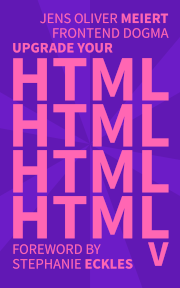Minimalism
Why and How to Write Minimal and Valid HTML, a Link Guide
On using all of HTML’s features and ensuring that HTML code is error-free—two surprisingly underused and unpopular approaches to writing HTML.
#23 · · development, html, conformance, performance, optimization
HTML Minifier Next (a Maintained Fork of HTML Minifier)
On providing an alternative version of HTML Minifier, critical web tooling that cannot remain unmaintained.
#22 · · development, html, optimization
The Magic of the Most Minimal HTML Possible (and Why We Don’t Make Use of It)
On challenging XHTML–HTML and regular redos, by looking at HTML–HTML, full separation of concerns, and iterations.
#21 · · development, html, conformance, maintainability
5 Ways to Reduce HTML File Size on Your Website, Step 0
The journey begins with an unpopular step.
#20 · · development, html, performance, optimization
DeepSeek and HTML
“What is the most minimal valid HTML document?”, DeepSeek-R1 edition.
#19 · · development, html, conformance

Now Available: Upgrade Your HTML V!
The newest part of the ebook series for HTML craftspeople and minimalists, touching on past, present, and future of the greatest document language ever specified.
#18 · · books, development, html, optimization
The Most Minimal Valid HTML Document
—isn’t that exciting, isn’t even new, but can use repeating in times of conformance neglect and AI-assisted coding.
#17 · · development, html, conformance

Upgrade Your HTML IV
HTML forms the heart of the Web. The beautiful thing is, HTML is easy to learn. Unfortunately, it’s difficult to master. In the Upgrade Your HTML series, I’m taking examples of HTML, discuss these examples, and make them a little better. I’m excited to announce the fourth book of the series.
#16 · · books, development, html, optimization
Minimal Dark Mode
What’s the easiest and fastest way to set up dark mode? Depending on the setup, something from one declaration to two rules.
#15 · · development, css
Minimal Social Markup
Every website and app these days relies on so-called “social markup,” metadata for a richer and prettier display in social media and messaging tools. On the absolute minimum you may need.
#14 · · development, html
Write HTML, the HTML Way (Not the XHTML Way)
You may not use XHTML (anymore), but when you write HTML, you may be more influenced by XHTML than you think. You are very likely writing HTML, the XHTML way.
#13 · · development, html
The 6 Ways of Writing HTML (and Their Combinations)
There are 6 general ways of writing HTML: unsystematic, valid, semantic, accessible, required-only, and hyper-optimized. These types make for 19 combinations—the ways we write HTML.
#12 · · development, html, conformance, semantics, accessibility
One Favicon to Rule Them All
I think the situation around favicons sucks. For an HTML minimalist, the ideal world consists of this when it comes to defining a website or app icon: one image file—no code. This is the minimalist’s dream, and we aren’t there yet—or are we?
#11 · · development
CSS: “:has()” and the Lost Paradigm
On the :has() pseudo-class and the forgotten school of ID- and class-less development.
#10 · · development, html, css

Upgrade Your HTML III
If you care about HTML as a craft, if you consider yourself an HTML minimalist, if you believe in pushing for boundaries (and sometimes overdoing it), then this is a right book (and a right book series) for you—with 10 fresh examples from the field that get inspected and improved.
#9 · · books, development, html, optimization

Upgrade Your HTML II
If you care about HTML as a craft, if you consider yourself an HTML minimalist, if you believe in pushing for boundaries (and sometimes overdoing it), then this is a right book (and a right book series) for you—with 10 new examples from the field that get inspected and improved.
#8 · · books, development, html, optimization

Upgrade Your HTML (the Booklet)
I’ve written a very short book on improving HTML code: Upgrade Your HTML. Upgrade Your HTML is about one thing: Picking examples of HTML in the wild, and explaining how to make that code better. Kindly. Constructively. Thoroughly, as finding a balance between detail and brevity permits.
#7 · · books, development, html, optimization
HTML and Performance: Leave Out Optional Tags and Quotes
As experts we should know what code is optional and leave it out, and our production systems should do a better job assisting us with that. After all the years of neglecting basic HTML optimization, let’s think about taking the next step and not ship optional HTML markup.
#6 · · development, html, performance
A Short Guide to Minimal Web Development
There’s an art and even a bit of magic around simple frontend code. Writing such code comes with a few preconditions: perhaps a firm understanding of core technologies, a lot of practice, public scrutiny, and then some. Thoughts.
#5 · · development
Understandable-Simple vs. Minimal-Simple Code
Code simplicity seems to be a goal quite worthwhile, contributing to better understanding, greater robustness, and higher quality. That’s at least what comes to my mind when looking at the matter…
#4 · · development
A Vision of Web Development
There is one thing every web developer should aspire to: writing the most minimal, semantically appropriate, valid HTML, and then never changing it. “Never” not in a sense of denial and refusal, but in the sense of a guiding light…
#3 · · development, html, semantics, conformance, maintainability, quality
A Few Words on HTML/CSS Frameworks
Public, or open, or external, HTML/CSS frameworks are rarely a good idea. Why? Because framework developers are outside of your organization and cannot know your needs. This simple fact, the inevitable ignorance of a third party, means that—
#2 · · development, html, css, frameworks
The World’s Best HTML Template
…again, exclusively, and as long as HTML 5 is in progress.
#1 · · development, html
